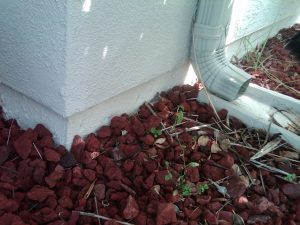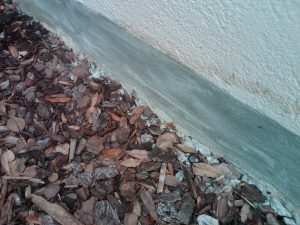I’m often asked the question of how bugs enter a home when it seems that there is no blatant way that we can visibly see. Doors are sealed, windows are tight but still there is a persistent problem with bugs getting in. In some houses that is a difficult question to answer because the home is well maintained yet in others it can be quite obvious. Insects are very adept at finding entry ways using heat, light, moisture, air currents and yes even blind luck. We as exterminators know our barriers do a great job but if you can seal them out that would be a much better solution.
Obvious but often overlooked
One area that often gets overlooked but is so obvious is the base of siding or stucco on a home. Usually this protective skin stops somewhere before it gets to ground level but I see plenty where it is buried pretty deep below grade. This covering on our home is meant to protect against weather, help insulate and beatify the exterior but in almost all cases it offers a super highway for insects. If you examine the base of the siding/stucco you’ll often find a gap at the base and this will run all the way around the home. Siding is not skin tight by design so moisture can’t build up and so the ready made space allows easy access for pests. Stucco on the other hand can be cemented right to the structure so it will have fewer openings but even a cranny 1/64th of an inch is more than enough for things like termites. The more modern stucco homes however are done on sheets of screen and end up with the same if not more of a slot at the base than traditional siding.
Inspect the base
To see if your homes siding or stucco has this opening you may need to get down on your hands and knees. The slot is pretty obvious and
you may be surprised to see just how big this gap can get. In my state it’s not uncommon to see small lizards popping their heads out from the base or running straight up the foundation disappearing in the crack as we walk by. If geckos can get in theses cracks it’s a sure bet spiders, roaches, earwigs and ants can as well. Once inside the void it’s anybodies guess if the intruders can make it all the way inside but they’ve at least come one step closer. With slab homes the sill plate is only inches away from that entry while basement homes may have more solid walls extending up. Either way they are in the first layer of your homes defense and if they can find their way into the stud walls it’s usually only a matter of popping over the sill and squeezing out the other side under the baseboard. If that’s to tight bugs can easily follow the wiring or plumbing that runs through the studs until they finally emerge inside your home. These are only two of the most likely paths and short of ripping off the outer layer of the home you may never know how porous your house really is.Sealing it up
I’m not a contractor and I’m not sure if this gap is intentional for the ventilation of your walls. Tightly sealing this area may be a mistake and not allow the walls to breathe and build up moisture. Mildew or rot could grow as a result and that to me would be far worse than an occasional bug. Check with a builder or contractor to see if this is a solution that would work for you before you break out the 10 gallon bucket of caulk. Besides the average home might be 180 linear feet around and the chances of you missing some areas or the seal not taking even in a spot or two are pretty good and that kind of defeats the purpose after all that work. I would however think that sealing up the larger gaps or those under some obvious entry points would help to slow them down. The loose siding or stucco under a water spigot area maybe or near doorways. Check out my pest proofing series articles.How to treat with pest control methods
The gap at the base of stucco or siding can be treated fairly easily using insecticidal dusts. You could spray but remember that gravity will kick in as soon as you do and most of your barrier will run down the foundation and go off target. Using a professional duster (which I sell) will allow you to puff or blow the powder into the void and although some may float out most will stay right up inside that void creating a long lasting effective barrier. Most dusts will last in this protected area for months so you shouldn’t have to reapply that often. Simply stick the application tip up under the siding and squeeze and you should get a few good feet of a solid treatment zone. Do this every few feet and within minutes your continuos entry point will be closed off to bugs all the way around the home.






